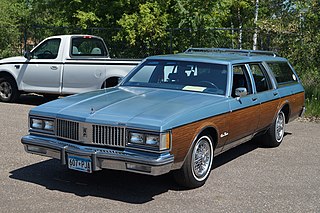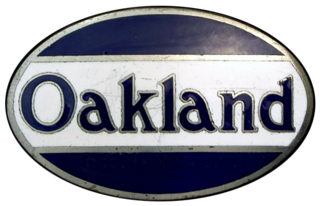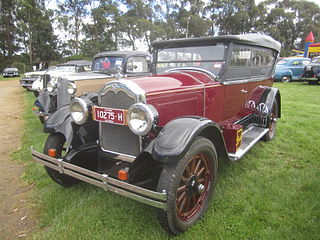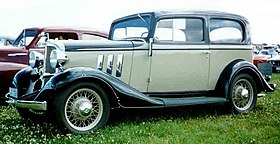
Pontiac was an American automobile brand owned, manufactured, and commercialized by General Motors. Introduced as a companion make for GM's more expensive line of Oakland automobiles, Pontiac overtook Oakland in popularity and supplanted its parent brand entirely by 1933.
The Chevrolet straight-six engine was an inline-6 engine made in three versions between 1929 and 1988 by the Chevrolet Division of General Motors. It replaced the Chevrolet Straight-4 engine171-cubic-inch (2.8 L) inline-four as the maker's sole engine from 1929 through 1954, and was the company's base engine starting in 1955 when it added the small block V8 to the lineup. It was completely phased out in North America by 1990, but in Brazil, GM held on to its fuel-injected version through the 1998 model year. It was replaced by the more recently developed V6 and four-cylinder engines. Chevrolet did not offer another inline-six until the 2002 debut of the General Motors Atlas engine in the Chevrolet TrailBlazer.

The Oldsmobile Custom Cruiser is an automobile that was manufactured and marketed by Oldsmobile in three generations from 1971 to 1992. The first full-size station wagon produced by Oldsmobile since the 1964 Oldsmobile 88 Fiesta, the Custom Cruiser was produced exclusively on the General Motors B platform as a five-door station wagon. The nameplate was first used by Oldsmobile from 1940 to 1947, denoting the top trim level of its C-body model line. 451,819 Custom Cruisers were sold over the years.

The 122 engine was designed by Chevrolet and was used in a wide array of General Motors vehicles. The 122 was similar to the first two generations of the General Motors 60° V6 engine; sharing cylinder bore diameters and some parts. The 122 was available in the US beginning in 1982 for the GM J platform compact cars and S-series trucks.

The Oakland Motor Car Company of Pontiac, Michigan, was an American automobile manufacturer and division of General Motors. Purchased by General Motors in 1909, the company continued to produce modestly priced automobiles until 1931 when the brand was dropped in favor of the division's Pontiac make.
The GM A platform was a rear wheel drive automobile platform designation used by General Motors from 1925 until 1959, and again from 1964 to 1981. In 1982, GM introduced a new front wheel drive A platform, and existing intermediate rear wheel drive products were redesignated as G-bodies.

In the late 1920s, American automotive company General Motors (GM) launched four companion makes to supplement its existing lineup of five-passenger car brands, or makes. The companion makes were LaSalle, introduced for the 1927 model year to supplement Cadillac; Marquette, introduced in 1929 for 1930 to supplement Buick; Pontiac, introduced for 1926 to supplement Oakland; and Viking, introduced for 1929 to supplement Oldsmobile. GM's fifth existing make, Chevrolet, did not receive a companion make. With the exception of Viking, each of the companion makes were slotted below their "parent make" in GM's pricing hierarchy.

The Chevrolet Superior Series F was launched in 1923, manufactured by Chevrolet for four years with a different series per year. The 1923 model was known as the Series B, the 1924 model was the Series F, for 1925 it was known as the Series K and the 1926 Superior was known as the Series V. It was replaced in 1927 by the Series AA Capitol. It was the first Chevrolet that didn't have a larger companion model and was the only car sold by Chevrolet in several body style configurations all supplied by Fisher Body. Each year new mechanical changes, appearance updates or optional features that became standard in subsequent years became expected of all GM products including Chevrolet. Body styles were separated into open and closed which meant closed included retractable glass in the doors and glass surrounding rear seat passengers. Standard items included tools, a jack for tire removal, speedometer, outside lockable door handles, ammeter, oil pressure gauge, dashboard light, choke pull knob, electric horn, ignition theft lock, and a two piece vertical ventilating windshield that allowed fresh air to enter the passenger compartment. Wheels were 30" and came standard with hickory wood spokes or optional pressed steel discs. For 1925, bumpers were offered optionally along with outside side view mirrors, heater for passenger compartment and a clock.

The Buick Master Six Series 40 and Series 50, based on the wheelbase used, was an automobile built by Buick from 1925 to 1928 and shared the GM B platform with the Oldsmobile Model 30. Previously, the company manufactured the Buick Six that used the overhead valve six-cylinder 242 cu in (4.0 L) engine in their high-end cars, and the Buick Four for smaller, less-expensive cars. Starting with 1918, they dropped the four-cylinder engine and designed a small six, which they called the Buick Standard Six, to replace that end of the market. They coined the name "Master Six" for the high-end cars, now powered by the 255 cu in (4.2 L) engine released the year before. The yearly changes were a result of a new business philosophy called planned obsolescence

The Chevrolet Standard was launched in 1933, initially as the Chevrolet Standard Mercury, by Chevrolet as a lower priced alternative to the 1932 Chevrolet Series BA Confederate that became the Master Eagle in 1933 and Master from 1934. It was advertised as the cheapest six-cylinder enclosed car on the market.

The Chevrolet Series AA Capitol is an American vehicle manufactured by Chevrolet in 1927. Launched in the year Ford changed from the Model T to the Model A, Chevrolet sold 1,001,820 Series AA cars, and under the direction of General Manager William S. Knudsen Chevrolet would overtake Ford’s dominance in the market internationally. The GM introduction of the GM A platform also introduced yearly appearance changes while using a corporate appearance from the newly established Art and Color Section headed up by Harley Earl which meant the Chevrolet Capitol and the Cadillac Series 314 shared a common appearance as both cars, as well as Oakland, Oldsmobile and Buick used Fisher Body, now owned by GM, as the sole provider of coachwork. Individuality between the brands was defined by the manufacturer of the engine, which was brand exclusive, and badging on the radiator. This model documents that the accelerator pedal was introduced as previous generations used a throttle installed in the center of the steering column along with the installation of a gas gauge installed in the dashboard and a centrally installed rear view mirror.

The Chevrolet Series AB National is an American vehicle manufactured by Chevrolet in 1928 to replace the 1927 Series AA Capitol. Documented production numbers show that 1,193,212 Series ABs were manufactured in a variety of body styles with 69,217 originating from the Oshawa factory alone. Chevrolet instituted serial number recorded on the front seat heel board on either the left or right side, using the listed numbers to designate the point of origin of the vehicle identified.

The Chevrolet Series AC International is an American vehicle manufactured by Chevrolet in 1929 to replace the 1928 Series AB National. In all, 1,328,605 Series ACs were manufactured in a range of ten body styles, with 73,918 from Oshawa. The Series AC was the first introduction of the overhead valve Chevrolet straight-6 engine since the 1915 Chevrolet Series C Classic Six, and was advertised as "A Six in the price range of the Four", and was only $10 more than the outgoing four-cylinder Series AB. To simplify production operations, each factory was designated one body style for national consumption and shipped by railroad to major American cities. The serial number of origin was relocated to the right body sill underneath the rubber floormat except for the roadster and phaeton, which were inscribed on the right side of seat frame. Prices listed started at US$525 for the roadster or phaeton to US$725 for the Landau Convertible.

The Chevrolet Series AE Independence is an American vehicle manufactured by Chevrolet in 1931 to replace the 1930 Series AD Universal. Calendar year production slipped by about eight percent to 627,104 cars as the Great Depression continued, but as Ford's output plummeted by nearly two-thirds, Chevrolet reclaimed first place in the American car sales table, and the 8th million car was produced August 25, 1931. Yearly appearance changes, technical updates and standard or optional features for 1931 included the introduction of the "quail" hood ornament, a curved tie-bar connecting the headlights, wire- spoked wheels became standard equipment, while optional equipment listed front and rear bumpers, covers for side mounted spare tires, spotlights and guide lamps that would turn with the front tires. William S. Knudsen was joined with M. E. Coyle as General Managers. In May of 1925 the Chevrolet Export Boxing plant at Bloomfield, New Jersey was repurposed from a previous owner where Knock-down kits for Chevrolet, Oakland, Oldsmobile, Buick and Cadillac passenger cars, and both Chevrolet and G. M. C. truck parts are crated and shipped by railroad to the docks at Weehawken, New Jersey for overseas GM assembly factories. Dedicated body style production continued while assignment changed from previous years based on demand.

The Chevrolet Series BA Confederate is an American vehicle manufactured by Chevrolet in 1932 to replace the 1931 Series AE Independence. Production slipped significantly from over 600,000 cars to 323,100 for the model year as the Great Depression continued, but was still sufficient for Chevrolet to retain first place in the American car sales table. Sales were also affected by cross-town rival Ford introducing the Ford V8 coupe and sedan. A new body style called a station wagon was produced in limited quantities by coachbuilder Mifflinburg Body Company of Mifflinburg, Pennsylvania.

The Chevrolet Master and Master Deluxe are American passenger vehicles manufactured by Chevrolet between 1933 and 1942 to replace the 1933 Master Eagle. It was the more expensive model in the Chevrolet range at this time, with the Standard Mercury providing an affordable product between 1933 and 1937. Starting with this generation, all GM cars shared a corporate appearance as a result of the Art and Color Section headed by Harley Earl. From 1940 a more expensive version based on the Master Deluxe was launched called the Special Deluxe. The updated corporate appearance introduced a concealed radiator behind a façade with a grille.
The Series 22 Special was a four-seat passenger car produced by the Oldsmobile Division of GM in 1910 and 1911. It was the first car engineered by Oldsmobile after it became a division of GM and began sharing a platform with the Buick Model 10. It became the entry-level model for Oldsmobile, replacing the discontinued 1909 Model 20 and the 1909 Model D, while Oakland Motor Car Company became GM's entry level brand as Chevrolet didn't join GM until 1917.

The Oldsmobile Six, also known as the Model 53, 54 and 55 (1913-1915) then a brief cancellation until it reappeared as the Model 37, 37A and 37B (1917-1921) was a top level sedan along with the Oldsmobile Series 40 junior vehicle produced by GM's Oldsmobile Division and was manufactured at Lansing Car Assembly in Lansing, Michigan. It replaced the Series 28 also known as the "Oldsmobile Autocrat" and was replaced by the Oldsmobile Model 30 in 1927, and shared wheelbases with the Buick Six.It continued to use the T-head engine for two years. The various bodystyles were supplied by Fisher Body of Detroit, MI. It competed with the Chevrolet Series C Classic Six as Chevrolet was an independent company before becoming a division in 1917. Oldsmobile also shared technology with GMC for commercial and industrial products.

The Oldsmobile F-Series was built from the 1928 through 1938. The first generation continued the tradition of adding a series number for each model year; F-28, F-29, F-30 and F-31. The second generation, signified by a completely new bodystyle appearance was built from 1932 through 1938, all having been manufactured in Lansing, Michigan. 1926 saw the introduction of GM's most recognized business model, the use of common platforms shared amongst the brands. Oldsmobile and Buick shared the GM B platform. The F-Series was shared with the Buick Master Six and was also known as the Oldsmobile Six which was introduced as a name earlier in 1913. The F-Series was Oldsmobile's entry-level product using the Oldsmobile straight-6 engine, while the Oldsmobile L-Series, with a Oldsmobile Straight-8 engine, was the top level vehicle. It replaced the Oldsmobile Model 30 introduced in 1923, and was replaced by the Oldsmobile Series 60 and Oldsmobile Series 70 introduced in 1938. It was exported to Japan as a knock down kit and assembled at Osaka Assembly in Osaka, Japan




















